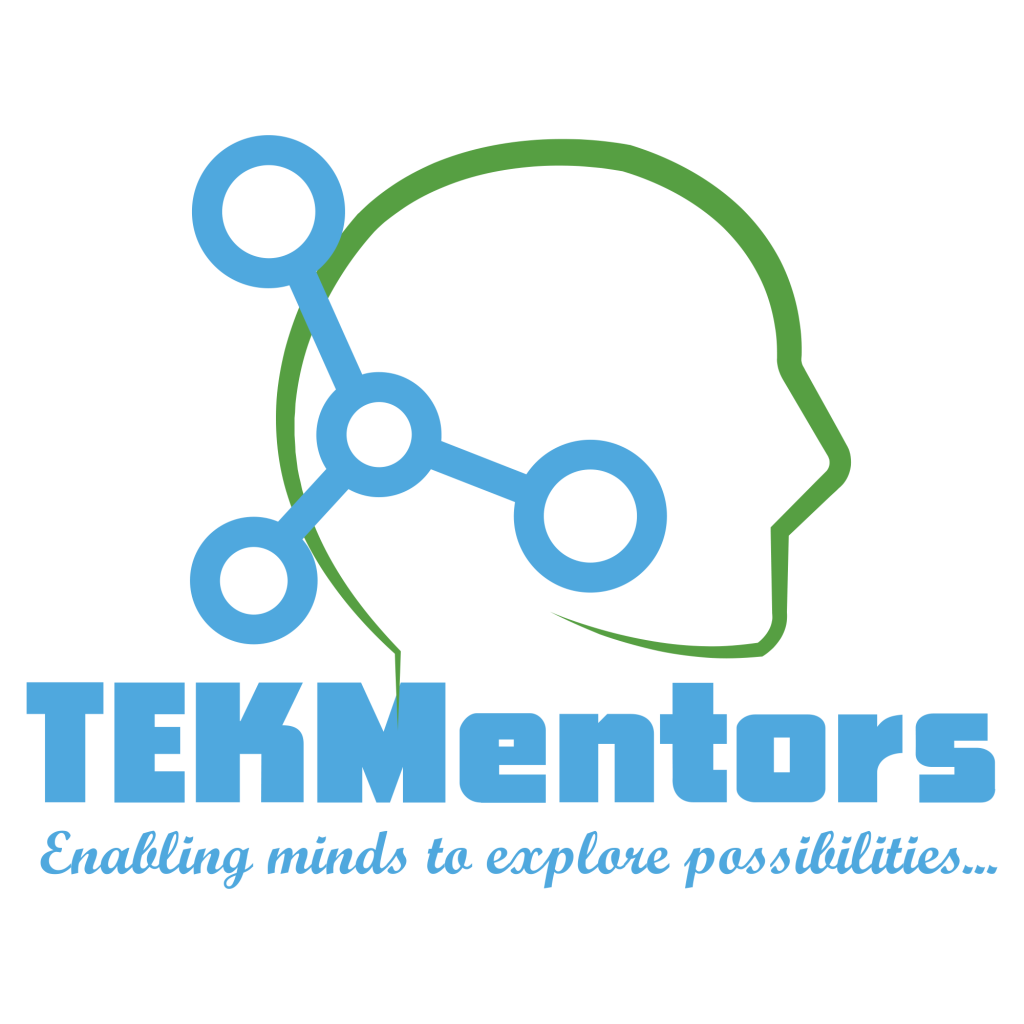
Introduction: Transformation with Purpose
As transformation expert John Kotter noted: “Change is hard when you do it to people. It’s powerful when you do it with them.”
In an era where 70% of digital transformation initiatives fail to reach their stated goals, business leaders face a critical inflection point. The challenge isn’t technology adoption; it’s strategic vision, cultural alignment, and executable roadmaps that deliver measurable ROI.
Digital transformation in 2025 demands more than cloud migration or AI implementation. It requires fundamentally reimagining how your business creates, delivers, and captures value in rapidly evolving markets. McKinsey research confirms that companies with comprehensive transformation strategies achieve 2.3x higher shareholder returns than industry peers, yet only 16% successfully scale their digital initiatives enterprise-wide.
For C-suite leaders navigating this complexity, the difference between transformation success and costly failure lies in a strategic roadmap that connects technology decisions to tangible business outcomes. This guide offers a field-tested framework to assess your current state, align stakeholder expectations, and accelerate your transformation with precision and purpose, anchored in value creation, not vanity metrics.
At TEKMentors, we’ve guided Fortune 500 enterprises and mid-market innovators through transformation journeys that deliver sustainable competitive advantage. Our approach transforms aspirations into measurable business impact.
What Digital Transformation Really Means Today
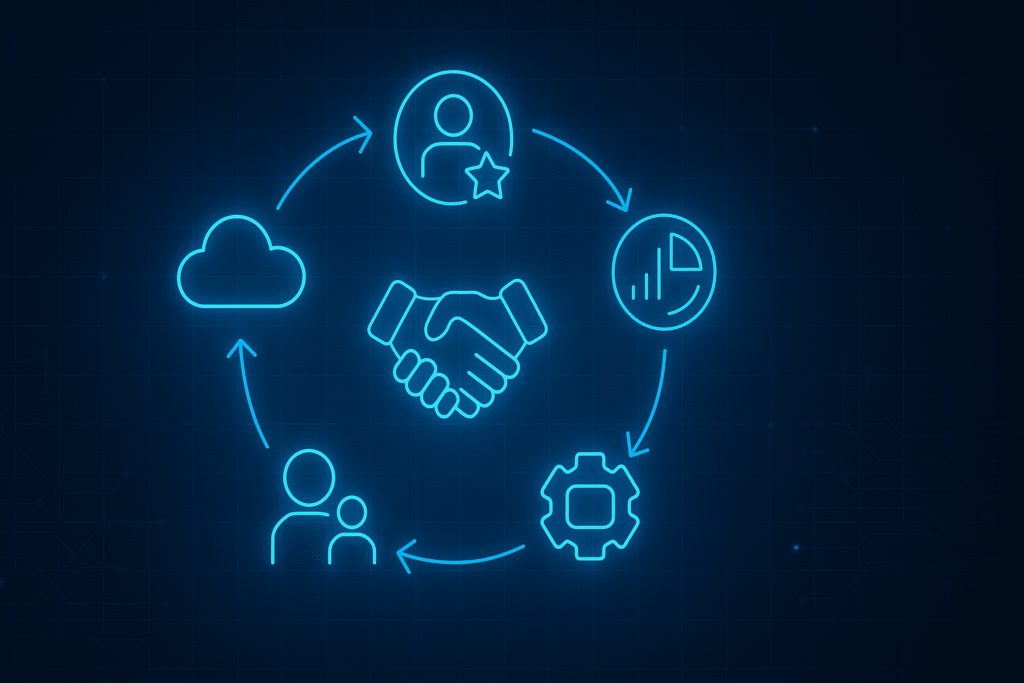
Digital transformation extends far beyond digitization. While digitization simply converts analog processes to digital (paper to PDF), genuine transformation reimagines your organization’s operating model, competitive positioning, and growth trajectory. It integrates technology, people, operations, and data into a synchronized system that delivers quantifiable business impact across every value stream.
Recent MIT Sloan research demonstrates that digitally mature organizations are 26% more profitable than industry competitors. Meanwhile, McKinsey analysis confirms that organizations aligning transformation goals with clear business outcomes are 2.7x more likely to succeed in their initiatives.
In 2025, transformation means:
- Creating adaptive, cross-functional teams that respond to market shifts in weeks, not quarters
- Building decision frameworks powered by real-time data insights and predictive analytics
- Evolving from project-based delivery to product-centric operating models with continuous feedback loops
- Orchestrating every touchpoint around customer experience and journey optimization
- Developing modular technology architectures that enable rapid experimentation and scaling
The 6 Pillars of Sustainable Digital Transformation
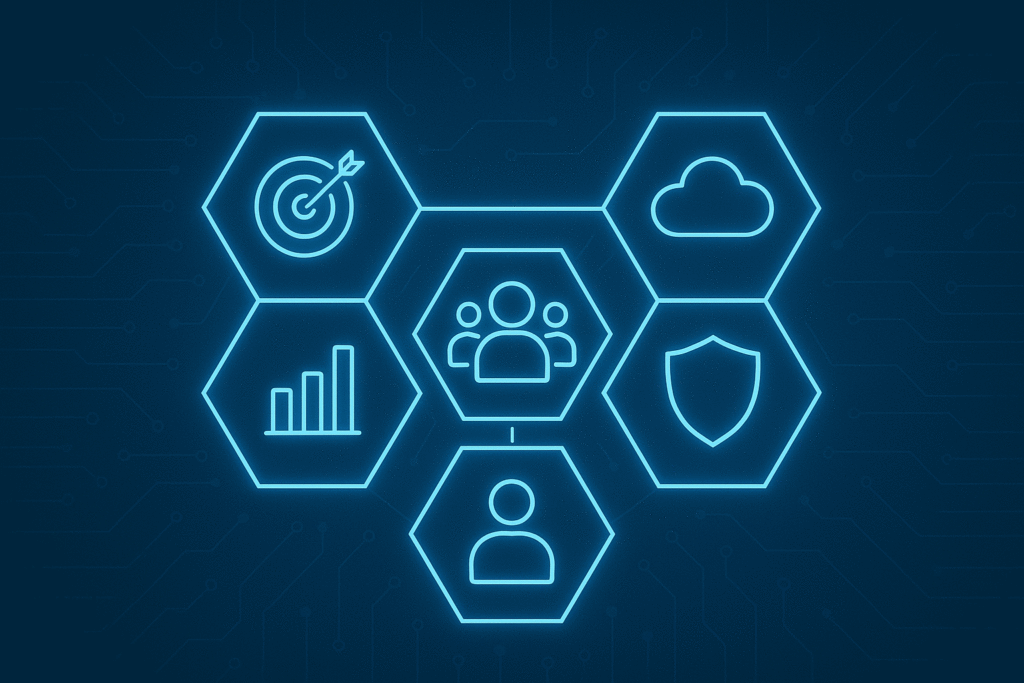
Based on frameworks from leading organizations (McKinsey, Boston Consulting Group, MIT) and our enterprise implementation experience, TEKMentors has identified six critical pillars that differentiate transformational leaders:
1. Vision & Strategic Alignment
- Anchor transformation initiatives in specific business objectives (revenue growth, market expansion, cost optimization, customer retention)
- Establish executive alignment on priorities, risk tolerance, and success metrics
- Translate strategic intent into clear technology roadmaps with measurable milestones
- Create feedback mechanisms that enable rapid course correction when market conditions shift
2. Workforce Enablement & Culture
- Evolve mindsets from process compliance (“what”) to value creation (“why”)
- Develop technical and business capabilities in Agile methodologies, cloud architecture, data analytics, and customer experience design
- Build psychological safety that rewards calculated risk-taking, transparent communication, and continuous learning
- Create centers of excellence that accelerate knowledge transfer across business units
3. Cloud-Native Engineering
- Migrate from monolithic legacy systems to scalable, microservices-based architectures (AWS, Azure, GCP)
- Implement infrastructure-as-code (IaC) and automated CI/CD pipelines with embedded security governance
- Optimize cloud economics through consumption monitoring, workload rightsizing, and reserved capacity planning
- Design for resilience with distributed systems, chaos engineering, and multi-region failover
4. Data Intelligence & Automation
- Unify fragmented data sources into accessible, governed ecosystems (data mesh, data fabric, Adobe Analytics)
- Democratize insights through self-service analytics and executive dashboards with actionable KPIs
- Deploy machine learning models that augment human decision-making and anticipate business opportunities
- Automate high-volume, rules-based processes to reduce costs and minimize error rates
5. Customer-Centric Operating Models
- Reorganize delivery teams around customer journeys rather than internal functions
- Implement real-time feedback channels that capture voice-of-customer (VoC) signals at each touchpoint
- Deploy experience orchestration platforms that enable personalization at scale
- Create closed-loop systems where customer insights directly influence product development
6. Governance & Change Management
- Establish change enablement office (CEO) that balance standardization with innovation Develop communication cadences that maintain stakeholder engagement across all levels
- Implement measurement frameworks that track both leading and lagging indicators
- Create sustainable change through behavioral reinforcement and visible quick wins
TEKMentors’ Transformation Framework: From Strategy to Execution
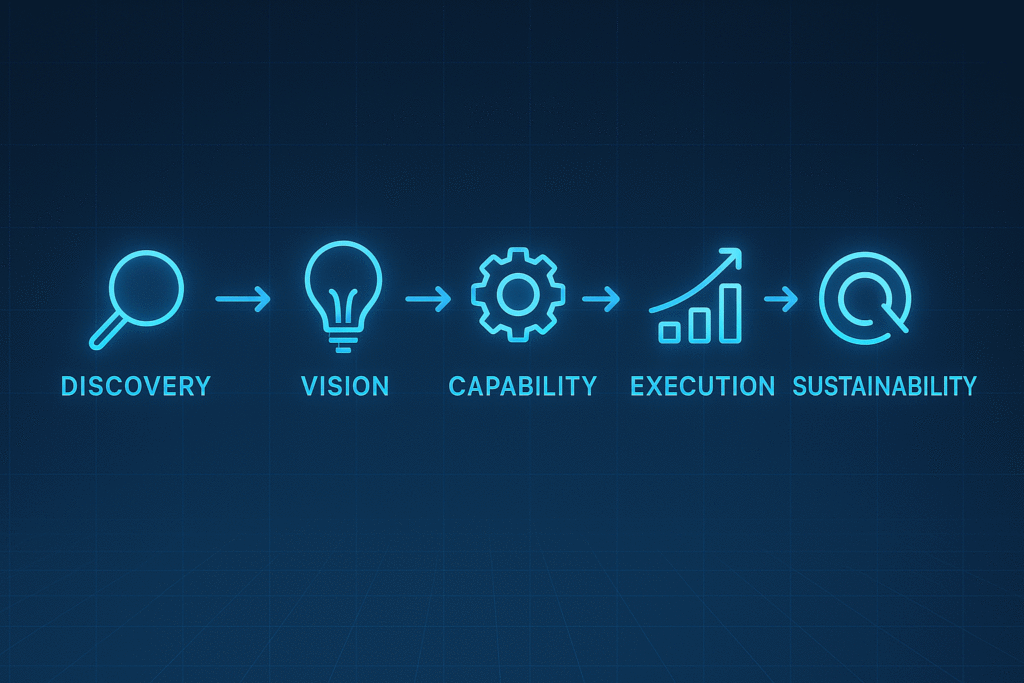
We recognize that every organization’s transformation journey reflects its unique market position, capabilities, and challenges. TEKMentors supports enterprises through a customized but structured model rooted in discovery, alignment, capability building, and continuous improvement:
Phase 1: Self-Assessment & Discovery
- Conduct comprehensive digital maturity assessments (using SWOT) across the technology, talent, and process dimensions
- Interview stakeholders at multiple levels to identify pain points, aspirations, and hidden constraints
- Map current-state architecture, data flows, and delivery pipelines to identify optimization opportunities
- Outcome: Digital Readiness Scorecard and Prioritized Opportunity Matrix
Phase 2: Vision & Value Definition
- Facilitate executive workshops to align business strategy with transformation objectives
- Define measurable value targets for each initiative (e.g., 25% reduction in time-to-market, 15% increase in customer engagement)
- Prioritize initiatives based on business impact, implementation complexity, and interdependencies
- Create executive dashboards that track progress against strategic objectives
- Outcome: Digital Transformation Roadmap with Business Value Mapping
Phase 3: Capability Buildout
- Design operating model changes that enable cross-functional collaboration
- Implement foundational technology platforms and integration patterns
- Develop talent through structured learning paths, certification programs, and mentoring
- Create reusable assets, playbooks, and architectural patterns that accelerate delivery
- Outcome: Scalable Delivery Model with Enabling Technologies
Phase 4: Execute, Iterate, Scale
- Launch strategic initiatives with dedicated teams using agile delivery methods
- Establish continuous feedback mechanisms to capture lessons learned
- Monitor progress through data-driven dashboards (GA4, Adobe Analytics, Power BI) focused on business outcomes
- Identify patterns that can be scaled across the enterprise
- Outcome: Validated Transformation Patterns and Success Stories
Phase 5: Innovation & Sustainability
- Implement innovation frameworks that balance exploration with execution
- Create forums for cross-enterprise learning and capability sharing
- Develop internal coaching capabilities to reduce external dependency
- Design self-sustaining governance models that evolve with organizational maturity
- Outcome: Self-Reinforcing Transformation Ecosystem
Avoiding the Common Pitfalls
Our experience guiding enterprise transformations has revealed consistent patterns of failure that organizations must proactively address:
- Technology-First Thinking: Implementing tools without clear business use cases or adoption strategies
- Measurement Malpractice: Setting aspirational goals without defining leading indicators (KPIs) or progress metrics
- Communication Gaps: Failing to articulate the “why” behind changes or create feedback channels
- Technical Debt Negligence: Underestimating legacy system complexity and integration requirements
- Siloed Execution: Launching transformation within IT without business alignment and ownership
- Talent Misalignment: Expecting new ways of working without investing in capability development
Case Study: Agile Transformation at a Leading Financial Institution
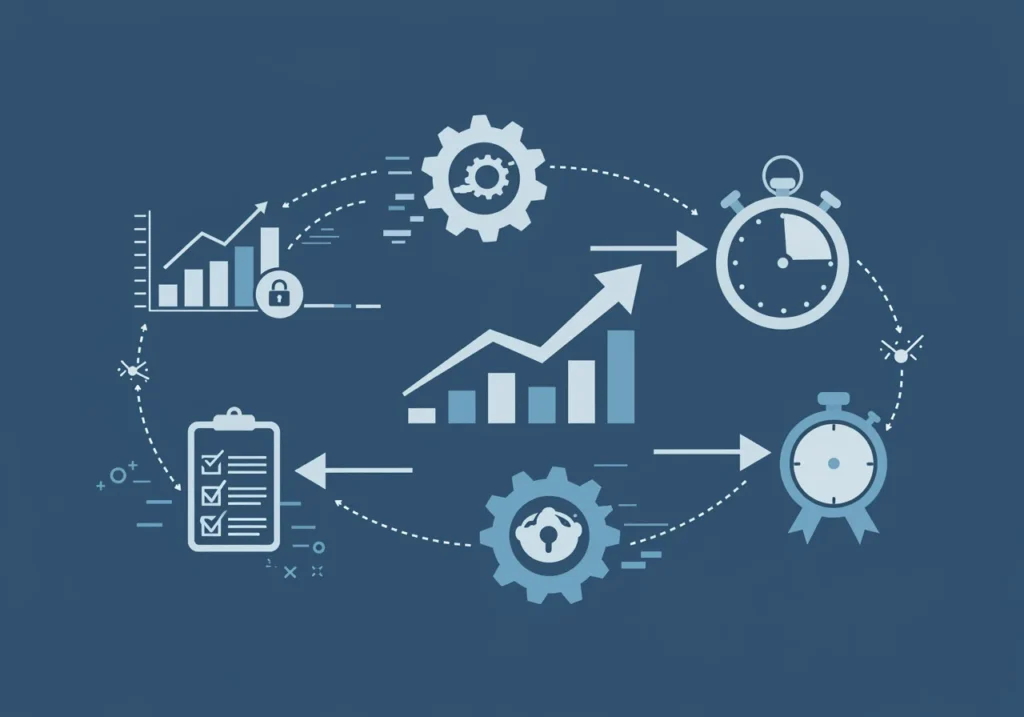
A UK-based banking enterprise partnered with TEKMentors to modernize its delivery model and technology foundation:
- Reduced time-to-market from 6 months to 90 days for core banking features
- Increased automated test coverage from 20% to 50%, reducing regression testing cycles by 65%
- Boosted annual release frequency by 50% while improving quality metrics
- Reduced production defect rate by 60% through DevOps practices
- Achieved measurable improvements in team engagement and stakeholder satisfaction
[Read the Full Case Study →]
How TEKMentors Can Help
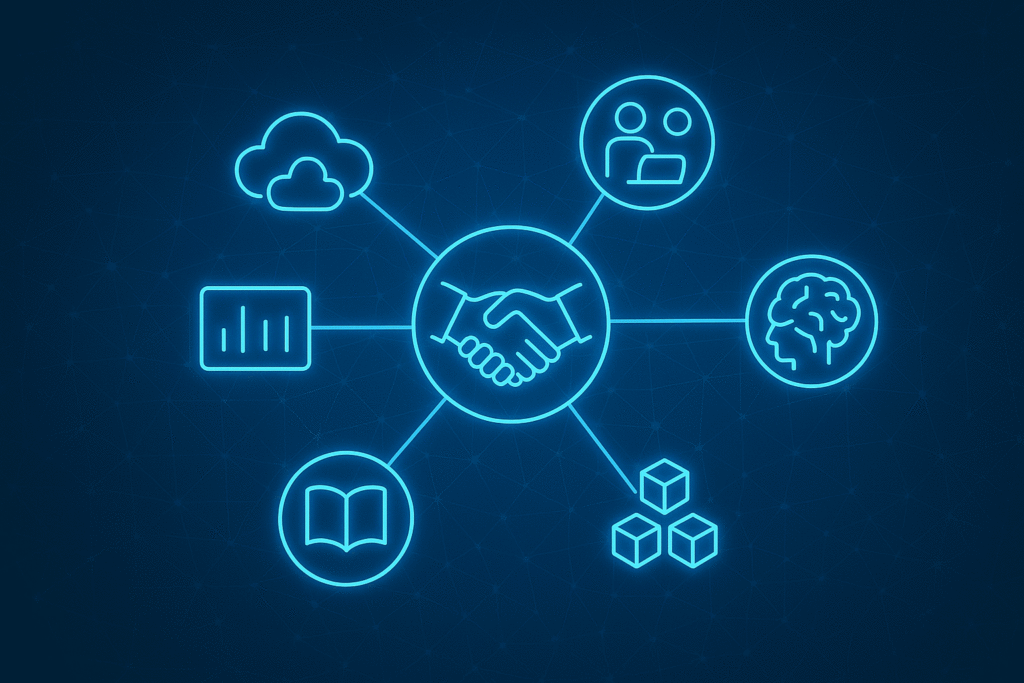
We partner with forward-thinking leaders to accelerate transformation through:
- Enterprise Digital Maturity Assessment
Our proprietary diagnostic framework evaluates your current capabilities across 28 dimensions, including technology architecture, delivery processes, talent readiness, and governance structures. This assessment provides a data-driven baseline and prioritized roadmap tailored to your organization’s specific challenges and objectives.
- Agile-at-Scale and Cloud Engineering Excellence
We guide organizations in transitioning from project-centric delivery to product-oriented models that respond rapidly to market opportunities. Through DevSecOps implementation, continuous delivery pipelines (CI/CD adoption), and modern cloud architectures (AWS, Azure, GCP), we enable organizations to release high-quality software faster while optimizing operational costs.
- Data Ecosystem and Intelligence Platforms (CDPs and AI/ML)
Our data specialists design and implement unified data platforms (Snowflake, Adobe Experience Platform, Google BigQuery) that transform fragmented information into strategic assets. We implement customer data platforms, analytics solutions, and machine learning capabilities that drive personalization, process optimization, and predictive decision-making.
- Upskill engineering and business teams through experiential learning
Beyond traditional training, we employ immersive learning approaches like technology dojos, peer mentoring networks, and hands-on sprint participation. This experiential learning transforms technical teams and business stakeholders into digital leaders capable of sustaining transformation momentum.
Our methodology blends strategic consulting with pragmatic delivery expertise, ensuring your transformation journey produces tangible outcomes, not just activities.
Lead with Intent, Transform with Impact
Digital transformation isn’t about digitizing yesterday’s processes. It is about reimagining tomorrow’s possibilities with clarity, adaptability, and purpose. With TEKMentors as your strategic partner, you don’t simply implement technology; you orchestrate meaningful change that creates a sustainable competitive advantage through people, processes, and performance.
In an era of continuous disruption, the most successful organizations don’t just respond to change: they anticipate and shape it. By aligning technology investments with clear business objectives, building adaptive capabilities, and fostering a culture of continuous improvement, you can position your organization to excel in the digital economy.

